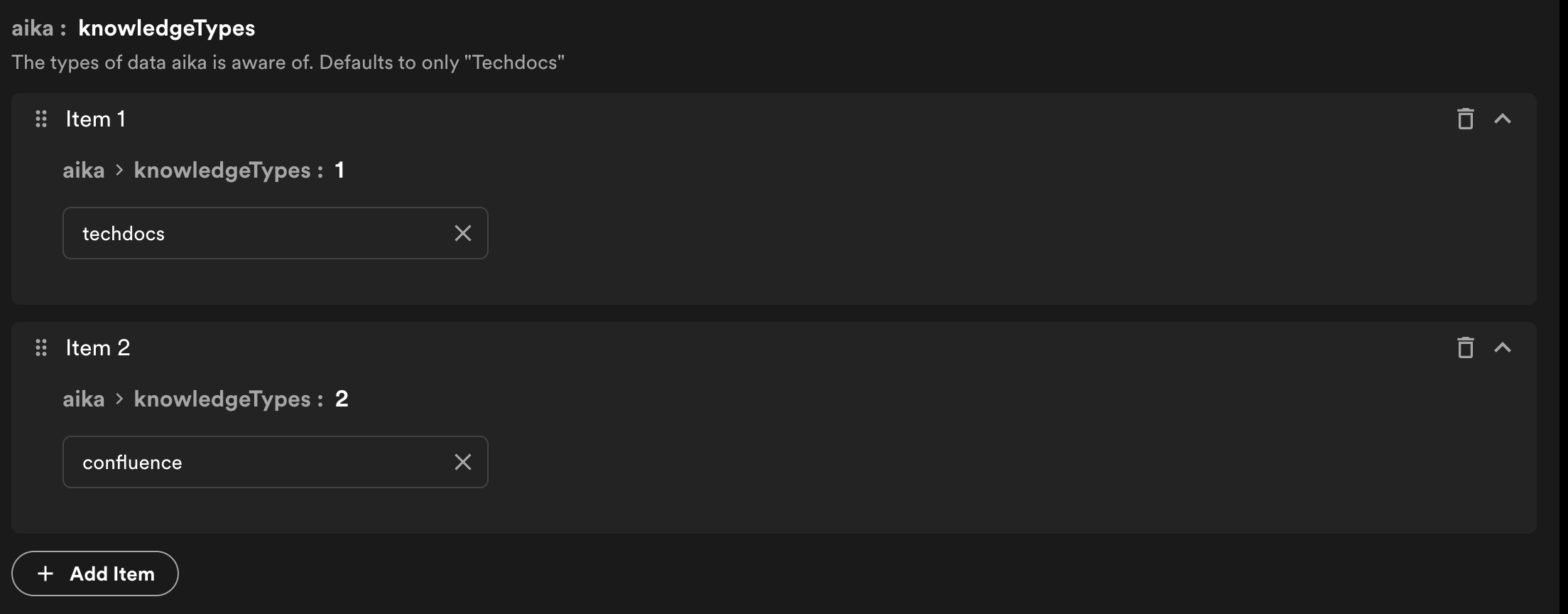Searching for Information
Overview
AiKA can search for information across your organization's repositories directly within Portal. By integrating with various information sources, AiKA can help you find answers and relevant content from your company's documentation, wikis, and other data sources.
How It Works
AiKA accesses search capabilities through Portal's Actions Registry, which provides a standardized way to expose Portal-native functionality to AiKA.
Search Actions
Portal includes these pre-registered search actions that AiKA can use:
- search: Performs traditional text-based searches using specific terms and phrases across company internal systems, documentation, and software catalogs
- query-semantic-search-engine: Uses vector-based semantic search to find contextually relevant information even when exact keywords don't match
For more information about the Actions Registry and available actions, see the Actions Registry documentation.
Example Usage
When you ask AiKA questions, it searches your organizational knowledge to provide relevant answers. Here's an example response where AiKA provides comprehensive instructions for registering vacation time:

Agentic Search vs. Single-Step RAG
If you're familiar with traditional single-step RAG (Retrieval-Augmented Generation) systems, you might wonder how AiKA's agentic approach compares. Both use the same semantic search technology under the hood to enhance LLM responses with organizational knowledge, but they differ in how that search is triggered and controlled.
AiKA delivers the same knowledge-enhanced responses you expect from traditional RAG systems, but with a smarter approach to retrieval.
Traditional RAG systems automatically inject documents into every query using semantic search, regardless of whether search is needed. AiKA instead lets the LLM decide when to search, which search method to use (semantic or keyword), and whether to search at all. This technique is sometimes called agentic RAG.
This means you get more targeted results for complex queries and the ability to combine multiple search strategies within a single conversation.
Configuration and Setup
AiKA's search tools currently draw from these internal sources:
- TechDocs: Internal documentation, including engineering, data, product, and, process docs.
- Confluence: Confluence spaces indexed by Backstage search can be used as a knowledge source.
- Catalog: Software catalog information can be used as a knowledge source.
In general, the search tools will be able to draw from any source that is indexed by Backstage Search, and requires that if you have a custom collator you've set up, you can add the name associated
with the collator to the aika > knowledgeTypes section in the Config Manager.
To configure AiKA to draw from specific sources, you can add the source to the aika > knowledgeTypes section in the Config Manager.
The most common sources are:
aika:
knowledgeTypes:
- techdocs
- confluence
- software-catalog
This configuration is optional. It will default to only techdocs if unspecified.
Custom Knowledge Sources
By default, only the TechDocs knowledge source is enabled. To improve the relevance and accuracy of AiKA's answers, you can add other knowledge sources alongside TechDocs. Expanding your knowledge base helps AiKA better respond to more diverse queries.
Getting Started
If you want to add more sources, here are some helpful resources:
- Community-created collators Discover existing collators for different platforms and data sources. Using a community collator can save setup time.
- How to install custom packages in Portal Guidance for installing plugins in your Backstage instance.
- How to create a custom collator For when you want to index a data source not already supported.
Example: Adding Confluence as a Knowledge Source
1. Add the Confluence Collator Module
- Go to the Config Manager.
- Add the following module:
This module enables indexing Confluence content in your search backend.
@backstage-community/plugin-search-backend-module-confluence-collator
2. Configure the Module
- Review the Confluence collator module documentation to identify required configuration fields (such as Confluence base URL, credentials, etc.).
- In the Config Manager, navigate to the search plugin configuration at
/config-manager/search. - Update your configuration values to include the Confluence collator settings.
3. Register the New Document Type with AiKA
- After adding the module, a new document
type(see: collator code) will be available. - To make AiKA aware of this new knowledge source:
- Navigate to AiKA's configuration in Config Manager at
/config-manager/aika. - Update the
knowledgeTypelist to include the new document type (e.g.,confluence).
- Navigate to AiKA's configuration in Config Manager at

4. Re-index the Knowledge Base
- After configuration, re-index your knowledge base (by default, it will start on its own. It may take a couple of minutes to fully execute). This process will make the new Confluence documents available to AiKA for answering queries.